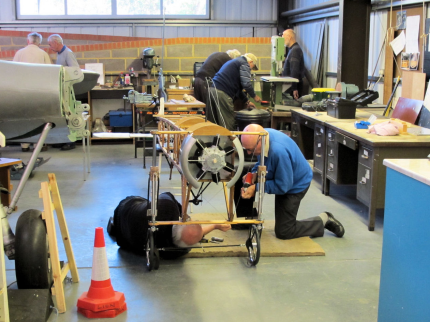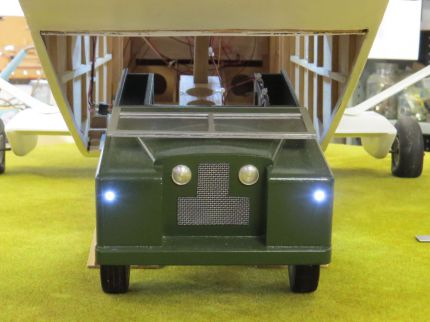
Special Projects
Replica Blériot
Volunteer technicians building a half-size replica of a Blériot monoplane in 2014 to mark the centenary of the first aircraft to land in the Woodley area in 1914. The wheels are from a Silver Cross pram.
In early 2013, when the Blériot replica was finally completed, it was lifted into place on a specially manufactured display stand.
The Blériot propeller was fashioned by Chris from a mahogany-like piece of tropical hardwood.
Model Spitfire
Sometime in the summer of 2015, a model Spitfire kit was donated to the museum. It was of wooden construction and the volunteers assembled it in our workshop. It was decided to acquire and fit a motor to drive the propeller and to make the control surfaces active. This would include making the undercarriage retractable in an authentic way. The volunteers were faced with quite a challenge, not least was the fact that the kit seemed to be only 85% complete.
The model Spitfire in position in the museum
The volunteers were faced with quite a challenge, not least was the fact that kit seemed to be only 85% complete. It was decided that using a normal remote control for a flying model wasn’t appropriate so a scaled-down mock-up of a Spitfire cockpit. It really was quite an undertaking to translate the movements of a control in the model to operate the converted transmitting controller was really not simple.
The remote on the left had to be converted so it could be operated by the cockpit on the right
The controls made to look as authentic as possible but of a larger scale to the ‘cockpit’ to make them robust and easier to operate. The controls in the ‘cockpit’ operate the throttle, undercarriage, flaps, ailerons, rudder and elevators.
The display was set up and commissioned in the museum in early September 2017 and soon proved to be very popular. Anybody visiting the museum can operate the Spitfire and learn from the information boards how the controls affect the orientation of an aeroplane. Volunteers are always on hand to help with this display.
Mini Delta
The Mini Delta simulator was designed and built by the museums’ volunteers for children to ‘pilot’. The Delta features authentic moving control surfaces. The rudder is controlled by the pedals, assuming the child has long enough legs. The control column operates the elevons and makes the aircraft pitch and roll.
Keith fixing the Delta simulator
‘Elevons’ is a contraction of the words elevators and ailerons and they have to do the jobs of both. On the Mini Delta they work with realism, in other words they work together when pitching, and opposite when rolling.
Model Skyvan
The Skyvan model, December 2017
The Skyvan model was donated some years ago by John Soper, a volunteer who is sadly no longer with us. John was a keen aero modeller and this piece had to be reassembled as far as the construction had already gone. The Skyvan is made mostly of balsa wood and would have been completed as a radio controlled flying model.
Graham resolving an electrical problem
In 2017, after the Spitfire model had been completed, the Skyvan was resurrected as a project. A small team of volunteers began working to complete the model for display in the museum. It includes a model Land Rover as its cargo.
An impression of how the Skyvan model will appear when completed. It is based on the livery of the Shorts demonstrator aircraft but obviously the customised registration is bogus.
This is the Land Rover model that will form part of the Skyvan display. The Skyvan cargo doors will be able to be opened and the Land Rover can be operated to drive down the ramp. The vehicle can then be retrieved, ramp rise back up and the cargo doors closed.
Model Land Rover unloading
Shorts SC-7 Skyvan 1A G-ASCN construction number SH.1828 as owned by Short Brothers and Harland Ltd.
This aircraft was built in 1962 fitted with Continental GTSIO-520 engines. In October 1963 it was fitted with Astazou II engines and in March 1965 with Astazou X. Registration was cancelled on 26 February 1968
Shorts SC-7 Skyvan 3 G-AVJX was used as a support aircraft for the aerobatic team RV Aviation registered OH-SBB but was written off on 1 November 1989 in the Aaland Islands, Finland. The construction number was SH.1838 and it was built in 1967 powered by two TPE331-2-201A.
The photograph is an early shot taken in Shorts livery before delivery for commercial use with Forrestair on 17 June 1968 and then registered VH-FSG.
Skyvans that are still airworthy have become popular with sky diving teams who prefer to launch themselves from the ramp rather than a side door.
Acknowledgements
Many thanks for the help, support and guidance on this and other articles within this website to the Museum of Berkshire Aviation. For the latest information, opening days, times and the location of the museum, visit the homepage of their website by clicking on the button below:
Information contained in these pages is correct as of 2018
My name is Gary Flint. I'm author, photographer & illustrator for Postcards from Slough. If you wish to make any comments on the contents of the website please click on the ladybird below:
Gary Flint
08/03/1961 - 09/04/2019
Postcards from Slough is an independently funded website. We are open to offers of sponsorship from companies that have any connections to the town. To contact us please click on the ladybird below:
Chalvey Community Forum
Postcards from Slough is linked with a local action group the Chalvey Community Forum. The group liaises with various local organisations in order to improve the quality of life for residents in the ward of Chalvey and Salt Hill. To learn more please click on the maidenhair leaf below:
Museum of Berkshire Aviation
I volunteer as a guide at the Museum of Berkshire Aviation. It is a special museum and if you would like to know more about the museum then please click on the motif below:
To learn more about the museums activities while staying within this website click on the tab at the top of the page or on the motif below:
Graces Guide
Postcards from Slough uses some images from Grace's Guide. Click on the button below:
British Listed Buildings
Postcards from Slough contributes material to British Listed Buildings and uses the site for cross referencing purposes. Click on the button below:












